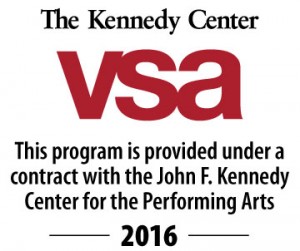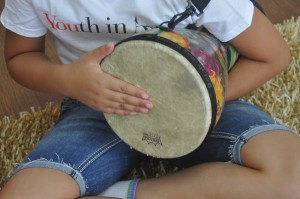“All Together Now” can be heard outside of the door of the classroom at Venetia Valley along with a host of other songs led by Mentor Artist William Rossell. Here are some of his thoughts on the process:
Written by Mentor Artist William Rossell
I have been leading music workshops in three Special Day Classrooms at Venetia Valley this year. I have students who have autism, Down’s syndrome, cerebral palsy, traumatic brain injury, and seizure susceptibility. Many of my students are nonverbal and have limited motor control.
I am a firm believer in the therapeutic power of music. Music is a powerful learning tool for any population and helps develop a huge range of skills that aid in cognitive development such as Concentration, Long and Short Term Memory, Pattern Recognition, Improvisation, Critical Thinking, Abstract Reasoning, and Communication. Music can also be used to reinforce common core academic subjects like mathematics and language arts. I have seen all of my students make amazing progress in these and other areas and I am very proud of all of them.
Some of the goals that we’ve been working towards are simple, such as being able to reach and touch musical icons on a schedule, or to hold onto mallets for drum-play.
Other goals include being able to verbalize wants, or when that’s not possible to communicate through other means. For example, I ask each student to help me come up with a rhythm by choosing long or short notes and they have to annunciate which notes they’d like. We’ve made huge progress on both of these fronts (fine motor and verbal communication) with all of the students. It’s been really exciting to see.
I have been using song in several of my classes to share the joys of singing. I accompany my students on guitar. Some of the songs that I have taught include “Down by the Bay,” “What a Wonderful World,” “All together Now,” and “Sunny Side of the Street.” Learning the words to these songs helps reinforce memorization and collaboration skills.
In my classes we also use many kinds of percussion instruments (frame drums, bongos, bass drums, tambourines, shakers, woodblocks, etc.) to make beautiful music. We usually start by playing a simple beat and we follow along as the beat speeds up and slows down and as it gets louder and softer.
Our typical musical exercises include beat counting/playing, call-and-response (which we call taking turns), making/playing basic long-short patterns, jamming, and playing to recorded music. This last exercise is one of the most fun. Each week, I ask one student to share with us a musical artist that they like and we play their music and accompany it with our drums. It is super fun and it gives the students a chance to try to verbalize their wants and to participate in making music with their favorite artists.
We also incorporate numbers and counting into our playing to show how numbers and math are an integral part of music.
In addition to these tools, I dedicate a portion of each lesson to “Question and Answer” or “Call and Response” in which I play short rhythmic patterns which the class carefully listens to and then plays back to me. This tool is especially useful in developing listening, memory and concentration skills.
Finally, because we want to have fun, we end our workshops with a free-form jam session which always leaves us with smiles!

